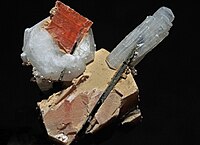
Photo from wikipedia
Antigorite is considered as the most important source of water in subduction zones, playing a key role during arc magma genesis. Although, these magmas seem more oxidized than mid-oceanic ridge… Click to show full abstract
Antigorite is considered as the most important source of water in subduction zones, playing a key role during arc magma genesis. Although, these magmas seem more oxidized than mid-oceanic ridge basalts (MORB), the possible inherent link between the oxidation state of arc magmas and serpentinite-derived hydrous fluids is still not well established. Here, we have performed dehydration experiments of natural antigorite serpentinite containing 5 weight percent (wt%) magnetite at 3 GPa and in a temperature range from 600 to 900 °C using a multi-anvil apparatus. These experiments aim to reproduce the different stages of H2O release, forming chlorite, olivine and orthopyroxene and water. Our experimental set up permits to preserve the intrinsic high oxygen fugacity (fO2) of serpentinite during dehydration. The new olivine and orthopyroxene which formed in equilibrium with antigorite, chlorite and magnetite have high XMg numbers setting up the oxygen fugacity to high values, between 3.1 and 4.1 log units above QFM (Quartz–Fayalite–Magnetite buffer). Hematite is observed concomitantly with high XMg in olivine, of 0.94–0.97, generally at low temperatures, below 800 °C, in coexistence with chlorite. Once the magnetite is destabilized, upon chlorite breakdown which occurs above 800 °C, the oxygen fugacity decreases to 3.7 due to the decrease of the XMg of silicates. This study demonstrates the highly oxidizing nature of the fluids released from antigorite dehydration. Thus, at high pressure and high temperature conditions, fO2-sensitive elements such as carbon and sulfur are expected to be mobilized under their oxidized form, providing an oxidizing context for arc magmas genesis and assuming that they are not completely reduced by their percolation through meta-gabbro, meta-basalts and meta-sediments.
Journal Title: Contributions to Mineralogy and Petrology
Year Published: 2020
Link to full text (if available)
Share on Social Media: Sign Up to like & get
recommendations!